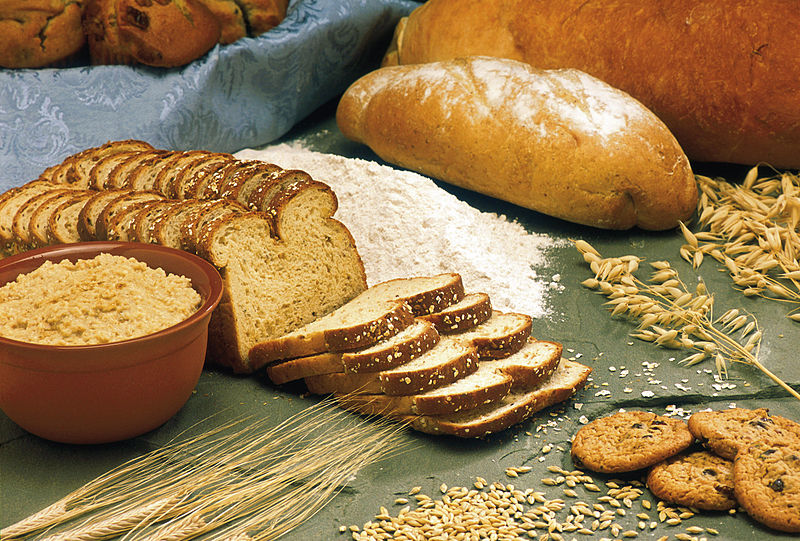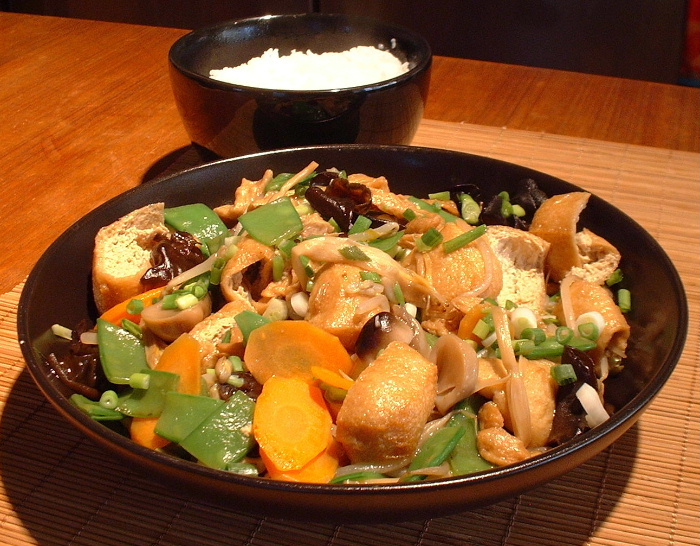Vegetarian cuisine
Vegetarian cuisine refers to food that meets vegetarian standards by not including meat and animal tissue products. For lacto-ovo vegetarianism (the most common type of vegetarianism in the Western world), eggs and dairy products such as milk and cheese are permitted. For lacto vegetarianism, the earliest known type of vegetarianism (recorded in India), dairy products such as milk and cheese are permitted.[1] The strictest forms of vegetarianism are veganism and fruitarianism, which exclude all animal products, including dairy products as well as honey, and even some refined sugars if filtered and whitened with bone char.
Vegetarian foods can be classified into several different types:
- Traditional foods that have always been vegetarian (cereals/grains, fruits, vegetables, nuts, etc.)
- Soy products including tofu and tempeh which are common protein sources
- Textured vegetable protein (TVP), made from defatted soy flour, often included in chili and burger recipes in place of ground meat
- Meat analogues, which mimic the taste, texture, and appearance of meat and are often used in recipes that traditionally contained meat.
- Vegans may also use analogues for eggs and dairy products
Foods used in vegetarian cuisine
Food regarded as suitable for vegetarians typically includes:
- Cereals/grains: maize, hempseed, corn, wheat, rice, barley, sorghum, millet, oats, rye, triticale, buckwheat, fonio, quinoa; derived products such as flour (dough, bread, pasta, baked goods).
- Vegetables (fresh or pickled); derived products such as vegetable fats and oils
- Edible fungi
- Fruit (fresh or dried)
- Legumes: beans (including soybeans and soy products such as tempeh, tofu, soy milk, and TVP), chickpeas, peas, lentils, peanuts)
- Tree nuts and seeds
- Spices and herbs
- Other foods such as seaweed (however seaweed is considered inedible by some strict vegetarians for the same reason it can be considered as non-kosher by some: the possibility that various tiny animals may be found adhering to it.)
Food suitable for several types of the vegetarian cuisine:
- Dairy products (milk, butter, cheese (except for cheese containing rennet of animal origin), yogurt (excluding yogurt made with gelatin), etc.) – not eaten by vegans and pure ovo-vegetarians
- Eggs – not eaten by vegans and pure lacto-vegetarians
- Honey – not eaten by most vegans
Cuisine that is traditionally vegetarian

These are some of the most common dishes that vegetarians in the Western world eat without substitution of ingredients. Such dishes include, from breakfasts to dinnertime desserts:
National cuisines

- Tamil foods like sambar, rasam, koottu, karembadu, upma, palya/taalimpu, kozhambu/koora, Aviyal, Olan, Kadala curry, Theeyal, Pulihora/puliyogare, Chammandi, Chutney, Chitrannams and breads like Appam, Puttu, pathiri, dosa, idli and vada.

- Egyptian cuisine in particular is rich in vegetarian foods. For reasons ranging from economics to the religious practices of the Coptic Orthodox Church, most Egyptian dishes rely on beans and vegetables: the national dishes, kushari and ful medames, are entirely vegetarian, as are usually the assorted vegetable casseroles that characterize the typical Egyptian meal.
Desserts and sweets

Most desserts, including pies, cobblers, cakes, brownies, cookies, truffles, Rice Krispie treats (from gelatin-free marshmallows, or marshmallow fluff), peanut butter treats, pudding, rice pudding, ice cream, crème brulée, etc., are free of meat and fish and thus are suitable for ovo-lacto vegetarians. Oriental confectionery and desserts, such as halva, Turkish Delight, are mostly vegan, while others such as baklava (which often contains butter) are lacto vegetarian. Indian desserts and sweets are mostly vegetarian like peda, barfi, gulab jamun, shrikhand, basundi, kaju katri, rasgulla, cham cham, rajbhog etc. Indian sweets are mostly made from milk products and are thus lacto vegetarian; dry fruit-based sweets are vegan.
Cuisine that uses meat analogues

These are vegetarian versions of popular dishes that non-vegetarians enjoy and are frequently consumed as fast food, comfort food, transition food for new vegetarians, or a way to show non-vegetarians that they can be vegetarians while still enjoying their favorite foods. Many vegetarians just enjoy these dishes as part of a varied diet.
Some popular mock-meat dishes include:
- Veggie burgers (burgers usually made from grains, TVP, seitan (wheat gluten), tempeh, and/or mushrooms)
- Veggie dogs (usually made from TVP)
- Imitation sausage (soysage, various types of 'salami', 'bologna', 'pepperoni', et al., made of some form of soy)
- Mockmeat or 'meatyballs' (usually made from TVP)
- Vegetarian or meatless 'chicken' (usually made from seitan, tofu or TVP)
- Jambalaya (with mock sausage and mock chicken, usually made from TVP, seitan, or tempeh)
- Tomato Omelette where tomatoes and a paste of flour is used to produce a vegetable omelette without the use of eggs.
- Scrambled eggs where tofu is mashed and fried with spices (often including tumeric, for its strong yellow color) to produce a dish that strongly resembles eggs.
- When baking, eggs are easily replaced by ground flax seeds, applesauce, mashed bananas, or commercial egg replacer
Commercial products
Commercial products, marketed especially towards vegetarians and labeled as such, are available in most countries world wide, in varying amounts and quality. As example, in Australia, various vegetarian products are available in most of supermarket chains and a vegetarian shopping guide is provided by Vegetarian/Vegan Society of Queensland. However, the biggest market for commercially vegetarian-labeled foods is India, with official governmental laws regulating the "vegetarian" and "non vegetarian" labels.
See also
References
- ^ http://www.ivu.org/history/renaissance/words.html
- ^ http://vegetarianfood1.com/?s=cuisine&x=0&y=0
- ^ a b Peter Brang. Ein unbekanntes Russland, Kulturgeschichte vegetarischer Lebensweisen von den Anfängen bis zur Gegenwart (An ignored aspect of Russia. Vegetarian lifestyles from the very beginning till the present day). Böhlau Verlag, Köln 2002 ISBN 3412079022
- ^ Vegetarian/Vegan Society of Queensland. "Vegetarian/Vegan Supermarket Shopping Guide". http://www.vegsoc.org.au/products.asp. Retrieved 7 May 2009.
From Wikipedia, the free encyclopedia


ไม่มีความคิดเห็น:
แสดงความคิดเห็น